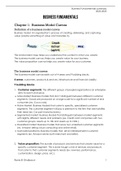Business Fundamentals summary
2022-2023
Chapter 1: Business Model Canvas
Definition of a business model canvas
Business model: An organization’s process of creating, delivering, and capturing
value (create something of value and monetize it.).
The environment map helps you understand the context in which you create.
The business model canvas: Helps you create value for your business.
The value proposition canvas helps you create value for your customer.
The business model canvas
The business model canvas exists out of 4 areas and 9 building blocks.
4 areas: customers, products & services, infrastructure and financial viability.
9 building blocks:
1. Customer segments: The different groups of people/organizations an enterprise
aims to reach and serve.
• Mass Market: Business models that don’t distinguish between different customer
segments. Goods are produced on a large scale for a significant number of end
consumers (ex. Coca cola).
• Niche Market: Business Models that cater to specific, specialized customer
segments. The customer segment will pay a premium to the firm that best satisfies
their need (ex. Car part manufacturers.).
• Segmented market: Business Models that distinguish between market segments
with slightly different needs and problems (ex. Credit card companies with two
customer groups: assets up to 10k and assets up to 100k ).
• Diversified market: Business models that serve two unrelated customer segments
(ex. Amazon selling cloud computing and online retail).
• Multi-sided platforms: Business models that serve interdependent customer
segments (ex. Amazon serves both merchant and seller).
2. Value proposition: The bundle of products and services that create value for a
specific customer segment. This is done trough a mix of services and products
that cater to that customer segments needs (ex. newness, performance,
customization, design, price, etc.).
Rania El Ghalbzouri 1
, Business Fundamentals summary
2022-2023
3. Channels: How a company communicates with its customer segments to deliver
value proposition.
4. Customer relationships: The type of relationships a company establishes with
specific customer segments
• Personal assistance • Communities
• Dedicated personal assistance • Transactional
• Self-service • Co-Creation
• Automated services • Long-term
5. Revenue streams: The cash a company generates from each customer
segment
• Asset sale • Licensing
• Usage fee • Brokerage fees
• Subscription fee • Advertising
• Lending/renting/leasing
Rania El Ghalbzouri 2
, Business Fundamentals summary
2022-2023
6. Key resources: The most important assets needed to make a business model
work.
• Physical resources: manufacturing facilities, buildings, vehicles, machines, systems,
point-of-sales systems, and distribution networks.
• Human resources: crucial in knowledge-intensive and creative industries. The
business model of a pharmaceutical company is reliant on experienced scientist
and a skilled sales force.
• Intellectual resources: brands, proprietary knowledge, patents and copyrights,
partnerships, and customer databases
• Financial resources: financial resources and/or financial guarantees, such as cash,
lines of credit, or a stock option pool for hiring key employees.
7. Key activities: The most important things a company must do to make a business
model work:
• Production: relate to designing, making, and delivering a product in substantial
quantities and/or of superior quality. Production activity dominates the business
models of manufacturing firms
• Problem solving; relate to coming up with new solutions to individual customer
problems. The operations of consultancies, hospitals, and other service
organizations are typically dominated by problem solving activities. Their business
models call for activities such as knowledge management and continuous
training.
• Platform/Network: dominated by platform or networkrelated Key Activities.
Networks, matchmaking platforms, software, and even brands can function as a
platform.
8. Key partnerships: the network of suppliers and partners that make a business
model work
• Strategic alliances between non-competitors.
• Coopetition: strategic partnership between competitors
• Joint ventures to develop a new business
• Buyer-supplier relationships to assure reliable supplies
➢ Optimization and economy of scale: optimize allocations of resources and
activities
➢ Reduction of risk and uncertainty
➢ Acquisition of particular resources and activities
9. Cost structure: describes all costs incurred to operate a business model
• Cost-driven: focus on minimizing costs wherever possible.
• Value-driven: focus on value creation
Rania El Ghalbzouri 3
, Business Fundamentals summary
2022-2023
• Fixed costs: Costs that remain the same despite the volume of goods or services
produced.
• Variable costs: Costs that vary proportionally with the volume of goods or services
produced.
• Economies of scale: Cost advantages that a business enjoys as its output expands.
Larger companies, for instance, benefit from lower bulk purchase rates. This and
other factors cause average cost per unit to fall as output rises
• Economies of scope: Cost advantages that a business enjoys due to a larger
scope of operations. In a large enterprise, for example, the same marketing
activities or Distribution Channels may support multiple products.
Workshop 1: Nespresso Business Model Canvas
Nescafe
Nespresso
Rania El Ghalbzouri 4




